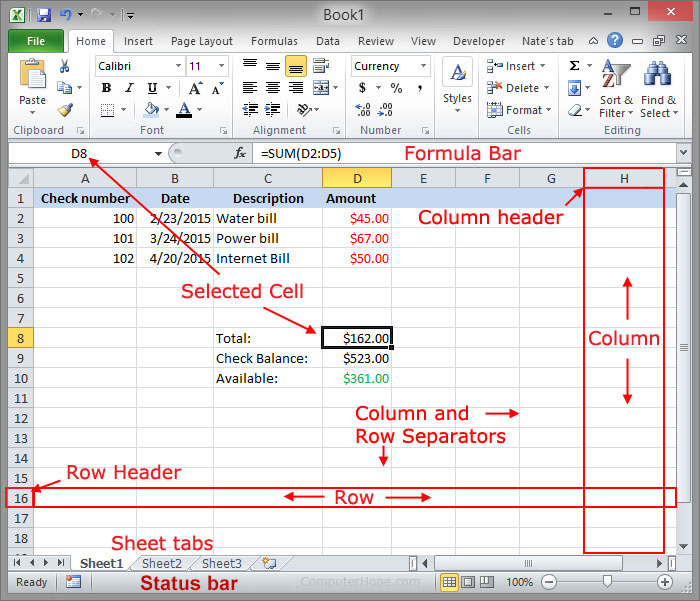Absolute cell reference
In Microsoft Excel and other spreadsheet programs, an absolute cell reference or ACR is a spreadsheet cell that remains the same even if it's copied or moved. An absolute cell reference is used to link two or more cells together, often for setting each cell to have the same value.
Absolute cell reference overview
One can identify an absolute cell reference by looking at the formula of the cell. If the formula contains one or more dollar signs ($), it is an absolute cell reference or a partial absolute cell reference. In the example below, the formula bar shows =SUM(D2:D5), a relative cell reference and not an absolute cell reference.

Examples of an absolute cell reference
Absolute column and absolute row reference
=$A$2
The above formula is telling the spreadsheet program to show the value of cell A1 in the current cell. For example, with the above Excel spreadsheet, if we entered this formula into cell B8, it's always "100" since that's the value in cell A2.
What makes the absolute cell reference different then a relative cell reference (e.g., =A2) is if we copied the cell formula in B8 and placed it in B9, it remains "100." A relative cell reference would use the next relative cell for its value, which would be A3 and would have a value of "101" in the cell.
Relative column and absolute row reference
=A$2
The above formula uses a relative column with an absolute row reference. If the cell formula was copied, the row remains the same (2), but the column is relative to where it's being copied.
Absolute column with a relative row reference
=$A2
The above formula is an absolute column reference with a relative row reference. If the cell formula was copied, the column remains the same (A), but the row is relative to where it's being copied.
Absolute cell reference with a relative cell reference
=SUM($A$2+B2)
Finally, the above formula always uses the value in A2, but add that value to the next relative cell. If the cell formula was copied from C2 to C3, it would become "=SUM($A$2+B3)."
In short, what makes the relative cell reference different than an absolute cell reference is that copying or moving the formula to different cells causes them to change. Absolute cells always point to the exact row or column described, regardless of where the reference appears.
Why would anyone need to use an absolute cell reference?
An absolute cell reference is not used as much as a relative cell reference. However, using an absolute cell reference can be helpful for when you need to copy a formula into multiple cells. For example, if you need a formula that always uses the same cell value in multiple cells, if it uses a relative cell reference it would change values when copied. However, if the formula contained an absolute cell reference, it could be copied anywhere and always keep the same cell value.
Absolute, Absolute location, Active cell, Formula, Relative cell reference, Spreadsheet, Spreadsheet terms
